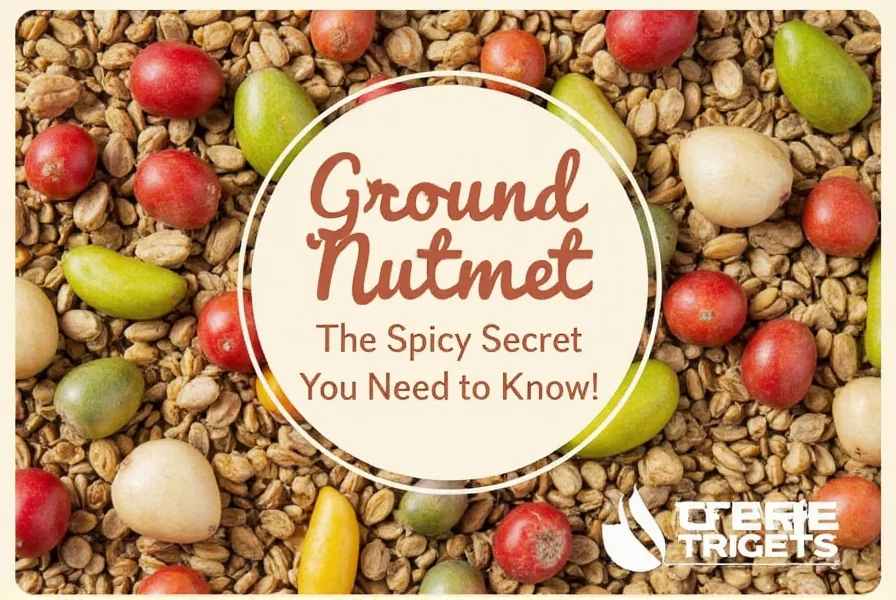Table of Contents
Introduction to Mace (Often Mistakenly Called 'Ground Nutmet')
The term "ground nutmet" is a common misconception. There is no such spice as "ground nutmet" — what people often refer to as "ground nutmet" is actually mace, a spice derived from the lacy, reddish covering (called an aril) that surrounds the nutmeg seed inside the fruit of the Myristica fragrans tree.
Mace has its own distinct flavor profile combining warmth, sweetness, and a slightly more intense, complex character than nutmeg. It's used in both sweet and savory dishes and adds remarkable depth to cooking. Understanding the correct terminology and proper use of mace is essential for culinary success.
Understanding Mace vs. Nutmeg
Confusion between "nutmet" and nutmeg stems from inaccurate spice terminology. There is no spice called "nutmet" — this appears to be a conflation of "nutmeg" and "mace." Let's clarify the relationship:
Mace is the bright red, lacy membrane that covers the nutmeg seed. When removed and dried, it becomes brittle and can be ground into powder. Nutmeg is the actual seed inside this covering. Though they come from the same fruit, they're harvested and processed differently, resulting in distinct flavors and uses.
| Feature | Nutmeg | Mace |
|---|---|---|
| Source | The seed of the nutmeg fruit | The dried aril (covering) surrounding the nutmeg seed |
| Flavor | Warm, sweet, and mildly spicy | More intense, sharper, slightly more pungent and citrusy than nutmeg |
| Usage | Widely used in both sweet and savory dishes | Favored in delicate sauces, light-colored dishes, and some baked goods where its brighter color and flavor profile work well |
| Appearance | Small, hard, light brown oval seed | Dried: orange-red, brittle flakes; Ground: vibrant orange powder |
Now that we've clarified this important distinction, let's explore how to use mace effectively in your cooking.
Practical Tips for Using Mace in Your Cooking
Using mace can elevate your dishes, but it requires understanding its unique properties. Here are some tips to help you make the most of this distinctive spice:
- Use it sparingly: Mace is potent, so a little goes a long way. Start with 1/8 teaspoon for most recipes and adjust to taste.
- Pair it with complementary spices: Mace works beautifully with cinnamon, allspice, and cloves. These combinations shine in holiday baking and spiced beverages.
- Add it early in cooking: Unlike nutmeg, which is often added toward the end, mace benefits from longer cooking times to fully develop its flavor in sauces and stews.
- Use in light-colored dishes: Mace's vibrant orange color can discolor light dishes, but its more delicate flavor makes it preferable to nutmeg in white sauces, béchamel, and light soups.
- Grind your own: Whole mace blades retain flavor longer than pre-ground. Invest in a small microplane to grind mace just before use for maximum flavor.
One of the best ways to experience mace is in traditional recipes where it's historically used. Try adding it to your next batch of béchamel sauce for lasagna, or experiment with a classic British bread sauce served with roasted poultry. The key is to balance its strong flavor with other ingredients to avoid overpowering the dish.
Another excellent application is in delicate desserts. Mace complements vanilla beautifully and works wonderfully in custards, crème brûlée, and light fruit pies. Just a small pinch can transform these dishes without overwhelming their subtle flavors.
The Ultimate Buying Guide for Mace
When it comes to purchasing mace, quality and freshness significantly impact your cooking results. Here are key factors to consider:
Key Features to Look For
- Form: Mace is available as whole "blades" (the dried arils) or ground powder. Whole blades retain flavor much longer and are preferable if you have a grinder.
- Freshness: Look for vibrant orange-red color in whole blades. Dull, brownish mace has lost its potency. For ground mace, check the "packed on" date and choose the most recent.
- Origin: High-quality mace primarily comes from Indonesia (particularly the Banda Islands), Grenada, and India. Indonesian mace tends to be more floral, while Grenadian mace is often more robust.
- Texture: Whole blades should be brittle but not crumbly. Ground mace should be fine and evenly textured without clumps.
Here's a comparison of mace products available on the market:
| Product Type | Origin | Flavor Profile | Best For |
|---|---|---|---|
| Whole Mace Blades | Indonesia | Floral, delicate, citrus notes | Infusions, long-cooking dishes, homemade spice blends |
| Ground Mace | Grenada | Bold, warm, slightly peppery | Quick breads, sauces, and dishes requiring immediate flavor |
| Organic Mace Powder | India | Milder, sweeter, less complex | Delicate desserts and light-colored sauces |
Professional chefs often prefer whole mace blades that they grind fresh as needed, as pre-ground mace loses its volatile oils and flavor much more quickly. If you're buying ground mace, purchase small quantities and store it in an airtight container away from light and heat.
Mace is particularly well-suited for:
- Classic European sauces: Béchamel, velouté, and cheese sauces where its delicate flavor enhances without overpowering.
- Savory dishes: Meatloaf, sausage, pâtés, and fish dishes—especially traditional British and Dutch recipes.
- Desserts: Vanilla custards, light fruit pies, and certain cookie recipes where nutmeg might be too strong.
- Specialty breads: Traditional holiday breads like Dutch speculaas or certain German Christmas breads.
Whether you're recreating historical recipes or experimenting with modern cuisine, mace is a versatile and distinctive spice that deserves a place in your well-stocked spice cabinet.
Frequently Asked Questions About Mace
What is the difference between mace and what some call "ground nutmet"?
"Ground nutmet" is not an official spice term—it's a common misunderstanding. Mace is the correct term for the spice made from the dried aril (reddish covering) surrounding the nutmeg seed. Nutmeg is the actual seed inside. They come from the same fruit but are different spices with distinct flavors and uses.
Can I substitute mace for nutmeg in recipes?
Yes, but with caution. Mace has a more intense, slightly citrusy flavor compared to nutmeg's warmer, sweeter profile. As a general rule, use ⅓ less mace than nutmeg when substituting (for example, ⅔ teaspoon mace for 1 teaspoon nutmeg). In delicate dishes where appearance matters, mace is often preferred as it doesn't discolor light-colored sauces.
How should I store mace to keep it fresh?
Whole mace blades retain freshness much longer than ground mace. Store whole blades in an airtight container in a cool, dark place for up to 2 years. Ground mace should be used within 6 months for optimal flavor. For longest shelf life, store mace away from heat, light, and moisture—never above the stove or in clear containers on a spice rack.
Why is mace more expensive than nutmeg?
Mace commands a higher price because it's more labor-intensive to produce. One nutmeg fruit yields only one piece of mace (the aril), while the seed becomes nutmeg. The aril must be carefully removed by hand, dried, and processed without damaging its delicate structure. Additionally, mace has historically been used in finer European cuisine, creating premium market positioning.
What are the best dishes to use mace in?
Mace shines in light-colored sauces (like béchamel), delicate desserts (vanilla custards, light fruit pies), traditional meat dishes (British pork pies, Dutch sausages), and certain holiday breads. It's particularly valued in recipes where you want warm spice notes without the darker color that nutmeg can impart. In Indian cuisine, it's used in garam masala and certain biryanis.
Is mace safe to consume in large quantities?
Like nutmeg, mace contains myristicin, which can be toxic in very large amounts (several tablespoons). However, normal culinary use (¼ to ½ teaspoon in a recipe) is perfectly safe. Pregnant women should consume mace in normal food amounts only, as excessive consumption may stimulate uterine activity. Always use mace in moderation as with any potent spice.
Conclusion
Now that we've clarified the confusion around "ground nutmet" and properly identified it as mace, you can appreciate this distinctive spice for what it truly is—a valuable culinary ingredient with its own unique properties. Mace's brighter, more complex flavor profile makes it an excellent complement (not replacement) for nutmeg in your cooking repertoire.
Understanding the difference between these two spices from the same fruit allows you to make more informed choices in your cooking. While nutmeg offers warm sweetness, mace provides a brighter, more citrusy note that works especially well in lighter dishes. With proper storage and measured use, mace can become an indispensable tool for adding nuanced flavor to your recipes.
Remember, the key to working with mace is restraint and understanding its distinct character. Use it to enhance rather than dominate your dishes, and don't be afraid to experiment with both whole blades and freshly ground mace to discover its full potential. Whether you're preparing a classic French sauce, a traditional holiday dish, or experimenting with new flavor combinations, mace deserves a place in your well-curated spice collection.

As you continue your culinary journey, keep exploring the subtle differences between related spices. Each discovery opens new doors to flavor creation, and understanding mace properly is a step toward greater mastery in your kitchen. With this knowledge, you're now equipped to use this often-misunderstood spice with confidence and creativity.











 浙公网安备
33010002000092号
浙公网安备
33010002000092号 浙B2-20120091-4
浙B2-20120091-4